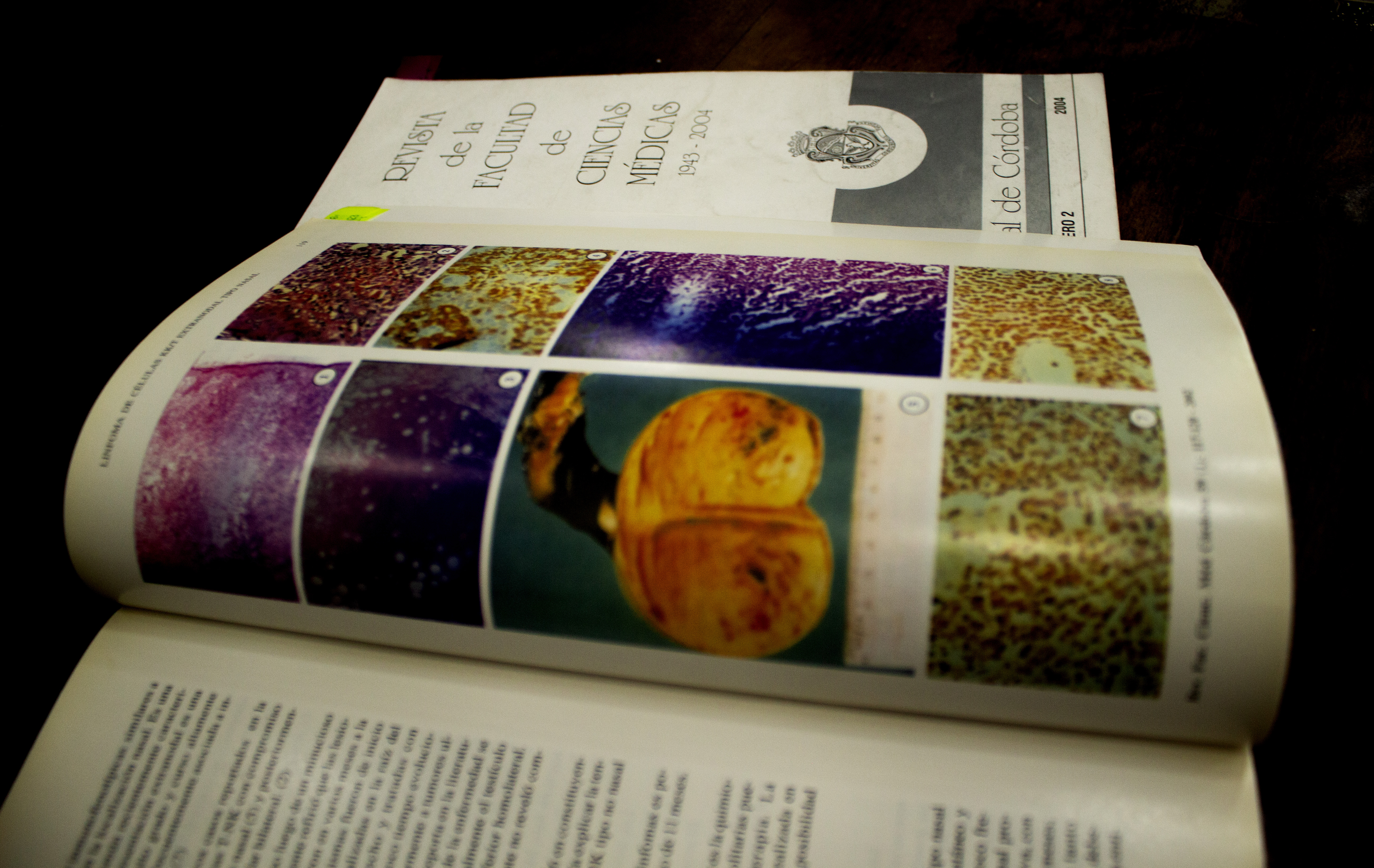MINOCA and Coronary Ectasia
a rare combination of causes of infarction
DOI:
https://doi.org/10.31053/1853.0605.v81.n1.43231Keywords:
myocardial infarction, MINOCA, myocardial ischemiaAbstract
Objective: to describe a patient with myocardial ischemia with multiple causes. Clinical Case: This clinical case describes a 58-year-old man with a history of hypertension, dyslipidemia, COPD and previous myocardial infarction (AMI). He went to the emergency room with chest pain and dyspnea. Findings included bibasal crackles, electrocardiogram with old anterior fibrosis, elevated NT-ProBNP, and echocardiogram with septoapical akinesia. During hospitalization, he experienced tachyarrhythmia and hemodynamic deterioration, undergoing electrical cardioversion (CVE). Non-ST segment elevation acute coronary syndrome (NSTEACS) complicated with ventricular arrhythmia and acute pulmonary edema was diagnosed. Coronary angiography revealed coronary ectasias without obstructive lesions, but with mild stenosis in three vessels. The patient was successfully treated with non-invasive ventilation, diuretics, vasodilators and anticoagulation. The discharge was granted with the plan to further studies to optimize and guide treatment and finally the diagnosis of Myocardial Infarction with Non-Obstructive Arteries (MINOCA) and the presence of coronary ectasias was addressed. Conclusion: it is important to highlight the non-ischemic causes in MINOCA and the association between coronary ectasia and cardiovascular events, which is why we emphasize the need for more studies to better understand the relationship between these phenomena.Downloads
References
1. Thygesen K, Alpert JS, Jaffe AS, Chaitman BR, Bax JJ, Morrow DA, White HD; Executive Group on behalf of the Joint European Society of Cardiology (ESC)/American College of Cardiology (ACC)/American Heart Association (AHA)/World Heart Federation (WHF) Task Force for the Universal Definition of Myocardial Infarction. Fourth Universal Definition of Myocardial Infarction (2018). J Am Coll Cardiol. 2018 Oct 30;72(18):2231-2264. doi: 10.1016/j.jacc.2018.08.1038.
2. Lindahl B, Baron T, Albertucci M, Prati F. Myocardial infarction with non-obstructive coronary artery disease. EuroIntervention. 2021;17(11):e875-e87.
3. Tamis-Holland JE, Jneid H, Reynolds HR, Agewall S, Brilakis ES, Brown TM, Lerman A, Cushman M, Kumbhani DJ, Arslanian-Engoren C, Bolger AF, Beltrame JF; American Heart Association Interventional Cardiovascular Care Committee of the Council on Clinical Cardiology; Council on Cardiovascular and Stroke Nursing; Council on Epidemiology and Prevention; and Council on Quality of Care and Outcomes Research. Contemporary Diagnosis and Management of Patients With Myocardial Infarction in the Absence of Obstructive Coronary Artery Disease: A Scientific Statement From the American Heart Association. Circulation. 2019 Apr 30;139(18):e891-e908. doi: 10.1161/CIR.0000000000000670.
4. Agewall S, Beltrame JF, Reynolds HR, Niessner A, Rosano G, Caforio AL, De Caterina R, Zimarino M, Roffi M, Kjeldsen K, Atar D, Kaski JC, Sechtem U, Tornvall P; WG on Cardiovascular Pharmacotherapy. ESC working group position paper on myocardial infarction with non-obstructive coronary arteries. Eur Heart J. 2017 Jan 14;38(3):143-153. doi: 10.1093/eurheartj/ehw149.
5. Richards GHC, Hong KL, Henein MY, Hanratty C, Boles U. Coronary Artery Ectasia: Review of the Non-Atherosclerotic Molecular and Pathophysiologic Concepts. Int J Mol Sci. 2022 May 6;23(9):5195. doi: 10.3390/ijms23095195.
6. Núñez-Gil IJ, Cerrato E, Bollati M, Nombela-Franco L, Terol B, Alfonso-Rodríguez E, Camacho Freire SJ, Villablanca PA, Amat Santos IJ, de la Torre Hernández JM, Pascual I, Liebetrau C, Camacho B, Pavani M, Albistur J, Latini RA, Varbella F, Jiménez-Díaz VA, Piraino D, Mancone M, Alfonso F, Linares JA, Rodríguez-Olivares R, Jiménez Mazuecos JM, Palazuelos Molinero J, Sánchez-Grande Flecha A, Gomez-Hospital JA, Ielasi A, Lozano Í, Omedè P, Bagur R, Ugo F, Medda M, Louka BF, Kala P, Escaned J, Bautista D, Feltes G, Salinas P, Alkhouli M, Macaya C, Fernández-Ortiz A; CAAR investigators. Coronary artery aneurysms, insights from the international coronary artery aneurysm registry (CAAR). Int J Cardiol. 2020 Jan 15;299:49-55. doi: 10.1016/j.ijcard.2019.05.067.
7. Boles U, Zhao Y, David S, Eriksson P, Henein MY. Pure coronary ectasia differs from atherosclerosis: morphological and risk factors analysis. Int J Cardiol. 2012 Mar 8;155(2):321-3. doi: 10.1016/j.ijcard.2011.12.010.
8. Markis JE, Joffe CD, Cohn PF, Feen DJ, Herman MV, Gorlin R. Clinical significance of coronary arterial ectasia. Am J Cardiol. 1976 Feb;37(2):217-22. doi: 10.1016/0002-9149(76)90315-5.
9. Ciliberti G, Finocchiaro G, Papadakis M, Westaby JD, Sharma S, Sheppard MN. Myocardial Infarction With Nonobstructed Coronary Arteries and Sudden Cardiac Death: A Clinical and Pathological Perspective. Circ Arrhythm Electrophysiol. 2020 Jul;13(7):e008302. doi: 10.1161/CIRCEP.119.008302.
10. Ciliberti G, Compagnucci P, Urbinati A, Bianco F, Stronati G, Lattanzi S, Dello Russo A, Guerra F. Myocardial Infarction Without Obstructive Coronary Artery Disease (MINOCA): A Practical Guide for Clinicians. Curr Probl Cardiol. 2021 Mar;46(3):100761. doi: 10.1016/j.cpcardiol.2020.100761.
11. Eyuboglu M, Eyuboglu C. Coronary Artery Ectasia in the Pathophysiology of Myocardial Infarction With Nonobstructive Coronary Arteries. Am J Cardiol. 2022 May 15;171:28-31. doi: 10.1016/j.amjcard.2022.01.043.
Downloads
Published
Issue
Section
License
Copyright (c) 2024 Universidad Nacional de Córdoba

This work is licensed under a Creative Commons Attribution-NonCommercial 4.0 International License.
The generation of derivative works is allowed as long as it is not done for commercial purposes. The original work may not be used for commercial purposes.







